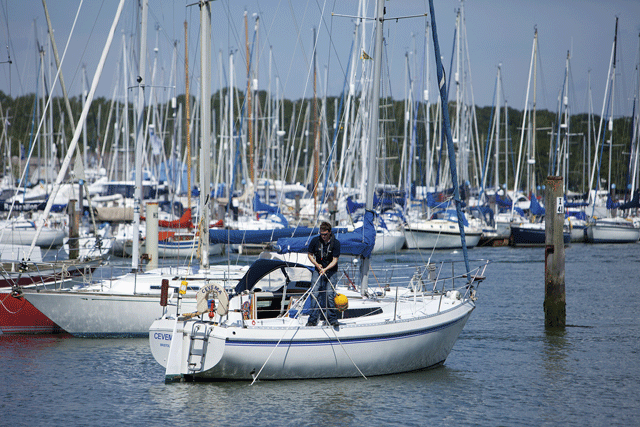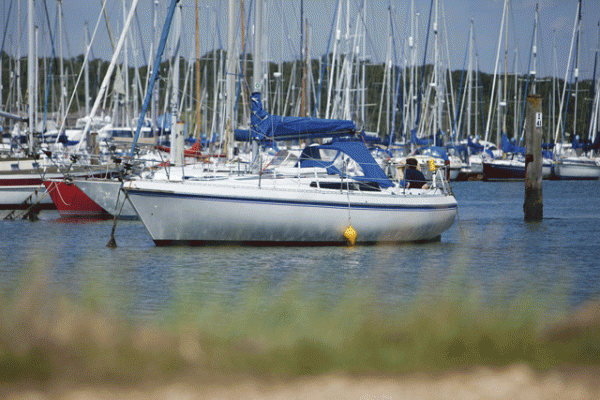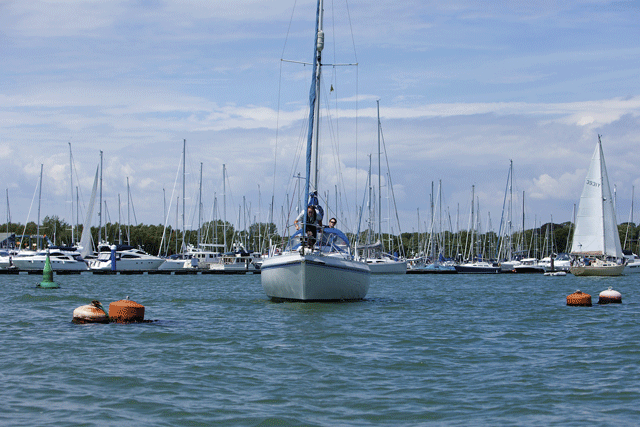Fore-and-aft trot moorings are cheaper than marinas and have many advantages - but they can be tricky to pick up. Here's how...
Despite the ever-increasing growth and availability of marinas around our coasts, you can still find reasonably-priced moorings in most places – whether you’re looking for an annual berth or are a short-term visitor.
In many of the rivers around our coastline, these take the form of fore-and-aft, or trot moorings.
Trot moorings have the advantage over a traditional swinging mooring in that they keep your boat moored in one place, with no risk of swinging into other vessels, and no risk of damage from the mooring buoy and its tackle in wind-over-tide conditions. However, for a first-timer they can be tricky to pick up – and in a breeze can be tricky for even the most experienced boat-handler.
There are two main types of fore-and-aft mooring. Most permanent moorings are simply connected to a line of weights on the seabed and have a single pickup buoy in the centre. Visitors’ trot moorings, on the other hand, especially in busy places like Lymington, are more often seen between pairs of buoys with mooring rings on top. You’ll need to thread your own mooring lines through the rings, and you’ll often have to raft alongside other boats.
We borrowed Cevema, a Gib’Sea 26 belonging to Warsash sailor Tim Powell, for the day. Tim’s sailing club mooring is located outside the busy main channel halfway up the Hamble River. Here, in an oasis of tranquillity, he has a typical trot mooring, with a single pickup buoy attached to two pairs of fore-and-aft lines which snake into the murky depths.
On the day, we had a light 10 knots of breeze blowing upriver, accompanied by a sharp spring flood tide. This made placing the boat in the right place and picking the buoy up relatively easy but, as you’ll see, it’s not always this simple.
Picking up a trot mooring in ahead

1: Ben motors slowly uptide to the buoy, aiming to place it amidships, where David waits with the boathook.

2: Ben stops the boat with the buoy alongside, keeping the bow head to wind and tide, while David hauls up the buoy. After lashing the tiller amidships, Ben moves forward to help with the lines.

3: David walks forward with the bow line, while Ben grabs the stern line and walks aft to secure it.
Picking up a trot mooring in astern
Picking up a mooring in astern can be easier, especially in lots of wind. If you are stern-to-wind, you avoid the bow being blown off, and the boat will weathercock around the stern. Be mindful of the possibility of getting lines around the propeller.

1: Ben starts his approach, single-handed this time. With wind-and-tide from astern, he can get in position some metres from the buoy and ferry-glide across to it with the engine in tickover.

2: With small steering movements, Cevema ferry-glides across to the mooring. As she reaches the buoy, with a small rudder adjustment and the engine put in neutral, she will stay there happily while Ben grabs the buoy.

3: It’s extra important to centre the rudder when doing this in astern. With this done, Ben gets the stern line on early.

4: Moored up safely. Don’t be afraid to abort the manoeuvre and try your approach again if it’s all going wrong.
In a breeze
Picking up a mooring in a breeze, especially a side-wind, it’s important to get the upwind line – be it bow or stern – on first. Here, David and Ben put the bow line on before working on the stern line. With one line on you’re securely moored and can attach the remaining line in less of a hurry.
Picking up a visitors’ trot mooring
Many visitors’ fore-and-aft moorings don’t have pickups – instead, you are expected to moor between two buoys. Often these buoys will have good-sized rings on top, but sometimes – as here – you’ll be faced with small rings low to the water.

1 Cevema motors up to the buoy. These have low-profile rings on the top, so David has to lie on the sidedeck with his hand at buoy level and a line ready to thread through a ring.

2: Ben positions the buoy amidships so that David can thread the line through. Ben keeps just enough way on the boat to be able to maintain steerage.

3: David pays out the line as Ben motors ahead towards the next buoy. David hands the line to Ben, who continues to pay it out until the bow reaches the next buoy.

4: As the boat approaches the buoy, Ben can control her forward motion with the tension on the aft line. It’s vitally important to let the line run freely – and make sure it’s long enough!
This was a particularly difficult mooring to pick up, owing to the small rings on the buoys. A snap-hook on the end of a long line would have made it much easier, allowing us to moor up quickly and safely. You can always haul the boat forwards or aft to exchange lines later.
Mooring in a crosswind
Picking up a mooring in a crosswind can be tricky, but all you need to do differently is approach diagonally. Keep enough way on that the bow doesn’t get blown off before it can arrive upwind of the forward mooring buoy. With forward line secured, you can manoeuvre to grab the stern buoy.
Mooring head to wind
If the trot is head to wind, motor slowly up to the upwind buoy and thread your bowline through it. Then it’s just a case of easing off the bowline so you drop back to the stern buoy.










